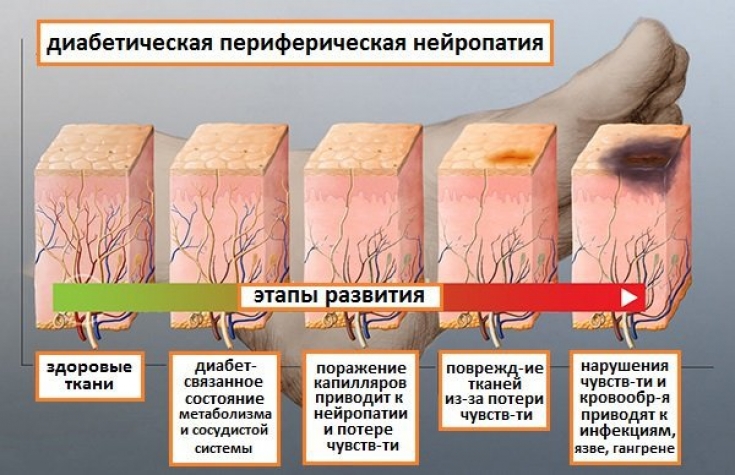Neuropathy may be the first sign of type 2 diabetes. Loss of sensation due to peripheral polyneuropathy is the most important risk factor for developing diabetic foot ulcers. In the phase of reduced glucose tolerance, neuropathy of small nerve fibers may occur. 11-25% of patients develop peripheral neuropathy in the pre-diabetic phase.
Diagnosis of diabetic neuropathy is based on the presence of a diagnosis of diabetes mellitus, typical symptoms and clinical findings, and the exclusion of other causes leading to neuropathy. Read more about the main clinical manifestations of damage to the nervous system in diabetes mellitus on the website estet-portal.com in this article.
Diabetic neuropathy in the form of symmetrical sensory-motor polyneuropathy
The most common form of neuropathy occurs in approximately 30-50% of diabetic patients. The pain begins mainly in the distal extremities. The patient is concerned about paresthesia and dysesthesia. In some cases, polyneuropathy is asymptomatic. In parallel with the decrease in sensitivity, paradoxical sensory hypersensitivity may occur with tactile stimulation of the affected area.
Dysesthesia – a type of sensory disturbance characterized by spontaneous or induced abnormal sensations, usually of an unpleasant, morbid connotation.
As a result of damage to the nerve fibers, the Achilles and plantar reflex falls out of the reflex sphere.
At first, deep sensitivity in the lower extremities is affected, and then other sensory modalities. Deep sensitivity is assessed with a tuning fork, tactile sensitivity with a monofilament.
Follow us on Telegram
Muscle atrophy as the disease progresses can cause ataxia and difficulty walking. Increased risk of falls and fractures.
The symptoms of diabetic polyneuropathy do not differ from those of other neuropathies. The differential diagnosis excludes vitamin B12 and folic acid deficiencies, excessive alcohol consumption, kidney failure, and hypothyroidism.

Diabetic neuropathy as small fiber neuropathy
May develop during the glucose intolerance phase. Typical symptoms include burning and paresthesia in the legs. Disturbances in the sensation of temperature reactions. The locomotor system is usually not affected in this form.
A terrible complication of diabetes mellitus - diabetic foot syndrome
If the patient is suffering from small fiber neuropathy (impaired temperature sensitivity without EMG changes), a 2-hour glucose tolerance test is recommended to diagnose possible impaired glucose tolerance.
This condition increases the risk of foot ulcers, gangrene and subsequent amputation.
You may also be interested in the article on our website estet-portal.com in the section "Dermatology": How to prevent the development of gangrene feet in diabetes
Diabetic neuropathy in the form of thoracalgia
The condition is poorly understood, but occurs fairly frequently. It begins at the age of 50-70 years with type 2 diabetes. The leading symptom is severe unilateral pain in the chest region, which reaches its maximum intensity within a few days.
There may be a sensory defect in the affected region and sometimes regional weakness of the pectoral or abdominal muscles. In the differential diagnosis, cardiological and somatic diseases of the abdominal region should be excluded. The illness often resolves spontaneously.

Diabetic neuropathy as mononeuropathy
The most typical mononeuropathies caused by diabetes are:
- painful neuropathy of the femoral nerve leading to quadriceps weakness,
- carpal tunnel syndrome (more than 30% frequency).
Carpal Tunnel Syndrome — neurological disease, manifested by pain and numbness of the fingers. The cause is compression of the median nerve between the bones, the transverse carpal ligament and the tendons of the wrist muscles.
Disturbances may also occur in other peripheral nerves. Neuropathy that affects large fibers can be objectively confirmed using electroneuromyography (ENMG). Usually the symptoms regress within a few weeks or months.
Diabetic ophthalmoplegia is manifested by damage to the optic nerve, less often – abducens and trochlear nerves. Often regression of symptoms occurs spontaneously.
Neuropathy of the autonomic nervous system as a manifestation of diabetic neuropathy
Diabetic neuropathy of the autonomic nervous system results in the following symptoms:
1. heart rate variability;
2.
3. impaired bowel function in the form of diarrhea and constipation;
4. dysmotility of the stomach, gastroparesis, nausea after eating;
5. dysuria;
6. erectile dysfunction;
7.
8. Changes in renal sodium filtration, diabetic edema, arrhythmias.
Follow us on Telegram
Prevention and treatment of diabetic neuropathy
Optimal control of diabetes is the basis for the prevention and treatment of diabetic neuropathy. Mononeuropathy and radiculopathy usually resolve spontaneously. The drugs of choice for treating neuropathic pain are tricyclic antidepressants, pregabalin and gabapentin.
Tramadol, duloxetine, or venlafaxine is the next line of therapy. Of the physiotherapeutic methods for the treatment of diabetic neuropathy, transcutaneous nerve stimulation turned out to be effective.
Treatment for autonomic neuropathy is usually symptomatic. Elastic bandaging and insufficient fluid volume should be replenished with orthostatic hypotension. Perhaps the use of pyridostigmine 60-180 mg / day, octreotide 25-200 mcg subcutaneously. Gastroparesis is relieved with metoclopramide or domperidone 10 mg 3 times daily. Treatment of risk factors for atherosclerosis will also reduce the risk of neuropathy in patients.
Read also on our website estet-portal.com the article Glycosylated hemoglobin: what you need to know about this indicator
According to the Evidence-Based Medicine Guidelines







Add a comment